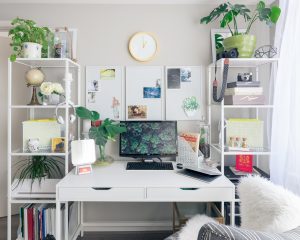Your learning environment can have a massive impact on your overall academic success. Research has found that many factors affect learning ability, including light, sound, comfort, and even colour. You must consider these factors carefully and create a productive study space that will maximise your learning potential. To help you achieve academic success, here are some useful tips on how to create the perfect study environment in your home.
Buy a quality desk and chair
 Comfort is an extremely important factor to consider when creating a study environment. If you are sitting comfortably, then you will remain engaged in your learning and absorb more information. Whereas, if you are sitting in an uncomfortable position, you are likely to become distracted and find it difficult to concentrate on your work. It is therefore essential that you have quality seating that provides you with the correct levels of comfort and support. You should also try and maintain good posture while you’re studying to avoid pain and injuries. Popular education blog Neo LMS advises that you can ensure good posture while studying by keeping both of your feet flat on the ground at all times and taking a regular movement break to get your blood flowing again. It is also worth investing in a quality desk so that you have a workstation where you can go to study. This will create a far more productive working environment than attempting to study while lying in bed or sitting on the sofa for example.
Comfort is an extremely important factor to consider when creating a study environment. If you are sitting comfortably, then you will remain engaged in your learning and absorb more information. Whereas, if you are sitting in an uncomfortable position, you are likely to become distracted and find it difficult to concentrate on your work. It is therefore essential that you have quality seating that provides you with the correct levels of comfort and support. You should also try and maintain good posture while you’re studying to avoid pain and injuries. Popular education blog Neo LMS advises that you can ensure good posture while studying by keeping both of your feet flat on the ground at all times and taking a regular movement break to get your blood flowing again. It is also worth investing in a quality desk so that you have a workstation where you can go to study. This will create a far more productive working environment than attempting to study while lying in bed or sitting on the sofa for example.
Remove any distractions
One of the main issues with studying at home is the risk of becoming distracting and being unproductive with your time. Your home is full of distractions like TVs, internet, roommates, and so on. To ensure that you get the most out of your study time, remove any distractions from your work area. Keep your mobile phone out of sight and avoid the temptation to look at it while studying. If you live with family members or friends, then be sure to make them aware when you’re studying and ask them not to disturb you. Remember that noise can act as a distraction and have a negative impact on your learning ability. You should therefore try and choose a quiet and calm area of your home to study in. That way, you can remain focused on your work and maximise your learning ability.
Add greenery to your workspace
 Bringing some nature into your workspace can be hugely beneficial. According to Stonehouse Furniture, being in nature can improve your mood, reduce stress, boost energy levels, and even increase life expectancy. Some simple ways to add greenery to your study space include purchasing indoor potted plants, keeping freshly cut flowers in vases, and using natural materials like wood and stone. You should also try to get as much natural light into your workspace as possible. Natural sunlight has been shown to boost learning ability and reduce the risk of developing certain health conditions like eye strain. You can easily take advantage of natural light by moving your workstation closer to windows or skylights.
Bringing some nature into your workspace can be hugely beneficial. According to Stonehouse Furniture, being in nature can improve your mood, reduce stress, boost energy levels, and even increase life expectancy. Some simple ways to add greenery to your study space include purchasing indoor potted plants, keeping freshly cut flowers in vases, and using natural materials like wood and stone. You should also try to get as much natural light into your workspace as possible. Natural sunlight has been shown to boost learning ability and reduce the risk of developing certain health conditions like eye strain. You can easily take advantage of natural light by moving your workstation closer to windows or skylights.
Choose a productive colour scheme
Colour can have a massive impact on how well you learn, so you should always consider this when creating a study environment in your home. Different colour schemes can have a significant effect on your mood. For instance, green has been shown to improve concentration and encourage feelings of relaxation and calm, making it a great choice in study spaces. Whereas, shades of red can be too stimulating and create feelings of anxiety and unrest. For that reason, it is often avoided in learning environments. Generally, it is best to stick with neutral colours on the walls, then add some colour and vibrancy with furniture and accessories. That way, you will gain the benefits of certain colours without the risk of creating a space that is distracting or overstimulating.
Final thoughts
 Nowadays, students choose to learn in a huge variety of non-traditional learning environments. Studying from home can offer several great benefits, but it’s important to remember that your study space can have a significant impact on your learning ability. Students learning in a positive study environment are more motivated, engaged, and achieve higher overall academic success. Whereas, students in poor study environments often struggle to concentrate and work productively. For that reason, you must consider your learning environment carefully and create a space that promotes and encourages learning. Use some of the tips above to help you create your ideal study environment at home.
Nowadays, students choose to learn in a huge variety of non-traditional learning environments. Studying from home can offer several great benefits, but it’s important to remember that your study space can have a significant impact on your learning ability. Students learning in a positive study environment are more motivated, engaged, and achieve higher overall academic success. Whereas, students in poor study environments often struggle to concentrate and work productively. For that reason, you must consider your learning environment carefully and create a space that promotes and encourages learning. Use some of the tips above to help you create your ideal study environment at home.
Ruby Clarkson is an emerging freelance writer with a passion for the arts, and if she could sing she would certainly be up on stage. When she isn’t writing, she’s either sketching, out in the garden or snuggled up with a book – with tea, of course.